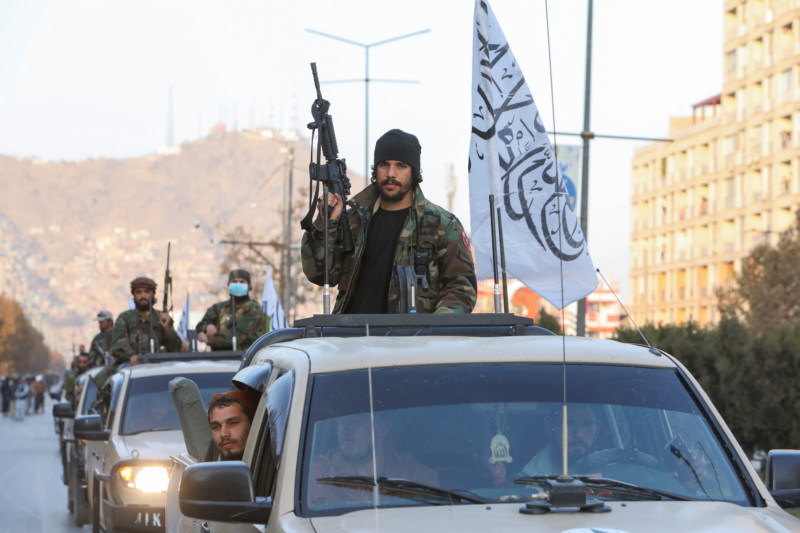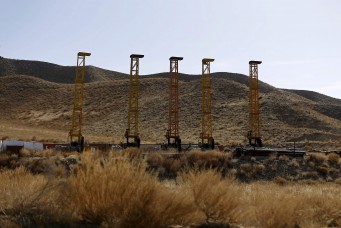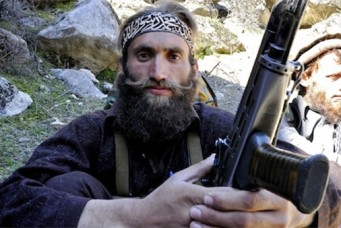Afghanistan and the New Taliban
What happens if the United States and other Western powers make a fresh beginning with the Taliban?

Taliban forces ride in a car during a Taliban military parade in Kabul, Nov. 14, 2021. Ali Khara/Reuters
Afghanistan under the Taliban may teeter under the brink of a systematic collapse. Onlookers question how the Taliban’s strict interpretation of Islamic law will be imposed on Afghan citizens and what the repercussions of the Taliban’s rule will be on the regional balance of power. In the near future, the United States and other Western countries may be tempted to support the new Taliban regime in Kabul because it has positioned itself as a grassroots organization with extensive support across Afghanistan and a safer alternative to the Islamic State—Khorasan Province, a newly formed local branch of ISIS. However, such an entente between the United States and the Taliban would be detrimental to American and Western prestige worldwide.
The Taliban’s rule over Afghanistan is set to push back social advances—especially those of women—across the country. Moreover, the ways in which the Taliban is currently governing the country are ultimately unsustainable. Should the country fall into a civil war, it would be divided among separate warring militias.
The next decisions leaders in Washington and other European capitals make regarding Afghanistan will be fundamental to maintaining the West’s role and influence in the modern world order. If Washington were to improve relations with the Taliban, as it may need to in order to combat a rising insurgency in the country, the international community would view the United States as going back on its earlier stance against a regime that harbored one of America’s biggest enemies, Osama Bin Laden.
Society and Economy
In the first hours after the Taliban seized power in Kabul, the banking sector froze thousands of citizens’ assets. This was expected since the foreign reserves ($9 billion) of the Da Afghanistan Bank, the country’s Central Bank, most of which is held in the United States, were already frozen due to the political developments. In addition, Western powers such as Germany followed the Americans’ lead and suspended their foreign aid. The International Monetary Fund and the World Bank followed suit. The result of this financial collapse was an exodus of Afghans seeking to avoid Taliban control. This new Afghan brain-drain has been the result of the Taliban’s return.
In addition, while schools and universities are now open for all male students, only in some provinces in the north—where the role of women has been more elevated than in the more conservative South—are female students over the age of 12 allowed to continue their education. According to the Taliban’s interpretation of Islam, a woman is forbidden to go outside of her home without being escorted by a close male relative. This precondition hurts a woman’s chances to pursue education and a career. If these conditions continue, the Taliban may be establishing a new apartheid state against women.
The lack of economic progress in the country coupled with distrust from international markets has produced a gloomy prospect for all Afghans. Soon, Western states will have to make a consensus decision on whether or not to aid Afghanistan economically so as to avoid a humanitarian disaster, despite human rights violations by the Taliban.
The Security Gap
Now that the Taliban are in Kabul, the continuous ties between the Taliban and Al-Qaeda can advance to a higher level, closer to that of the years leading up to September 11, 2001. It comes as no surprise that in celebration of the Taliban’s return to power, Al-Qaeda released a statement that “the way of Jihad is the only way that leads to victory”.
Despite the United States and NATO’s systematic military efforts, Al-Qaeda has managed to survive on the Afghan-Pakistani border over the past twenty years. Many reasons have contributed to this. First, Al-Qaeda’s elastic structure differs from the rigid hierarchy of the Islamic State. It was much easier for Al-Qaeda to exist in hiding from U.S. forces, with a small number of units rarely in contact with each other and scattered across Afghanistan and Pakistan’s mountainous provinces. Unlike the Islamic State, Al-Qaeda never tried to establish a capital or solidify its actions through a centralized network that would have made its fighters much easier to trace.
Second, Al Qaeda’s resilience can be traced to the organization’s support of the Pashtun tribes along the Afghan-Pakistani border. Due to the topography of the Pashtun land—remote and not easily accessible due to the high mountains surrounding it—NATO forces proved unqualified to control the region efficiently. The majority of the NATO troops that were stationed in Afghanistan were not trained in mountain operations, offering a military advantage to the insurgents to seek safe shelters in the remote mountain areas of Hindu Kush and beyond. This circumstance enabled both the Taliban and Al-Qaeda to move freely and undetected over a large expanse of terrain, triggering off one of the oldest stratagems in guerilla warfare: waiting for the other side to collapse without committing to an open confrontation. This indirect approach was assisted by the continuous material support of local warlords.
Today, the Islamic State—Khorasan Province (ISKP) has begun to challenge, both militarily and ideologically, the Taliban and Al-Qaeda in Afghanistan. The ISKP was formed in 2014 by Taliban and Al-Qaeda members who defected to the Islamic State. ISKP has turned against the new regime in Kabul for ideological reasons and is responsible presently for various attacks in Afghanistan and the wider region. The Kabul Airport Attack in late August resulting in 182 dead, among them thirteen U.S. soldiers, and 150 injured was the first ISKP strike but it has been followed by a rash of killings in the country, including in the northern Shia provinces. In these attacks, ISKP openly targeted Al-Qaeda and the Taliban, accusing both of being apostates of the global Islamic Caliphate. Importantly, despite ISKP killings and targeting of the Taliban, it maintains open communication with the Haqqani network, an influential faction inside the Taliban.
Failed State
Over the past four months, the situation in Afghanistan has devolved and seems to be trending toward full-blown political chaos. Already, military and political in-fighting has taken hold. For example, the Taliban have been implementing systematic purges against citizens and military officers of the pre-August political status quo. Meanwhile, the ISKP has been leading attacks against the Taliban, Al-Qaeda, and Shia groups. In turn, various Shia groups in the north, such as the Fatemiyoun Brigade, have armed themselves and moved against the ISKP. This affords Iran an opportunity, or alternatively a good excuse, to expand its influence in the Shia provinces of north Afghanistan, by claiming that it is sending armed forces to prevent a humanitarian disaster and protect the Shia Hazara minority.
Within the Taliban itself, the probability of a clash between its strongest factions— the Yaqoob and Haqqani networks—is always strong. The Yaqoob faction is under the leadership of Mohammad Yaqoob, the current minister of defence in Afghanistan and the son of the Taliban founder, Mullah Mohammed Omar. Yaqoob, 31, is young and ambitious, and popular among the Taliban supporters due to his father. This makes Yaqoob an open challenger for the current Taliban leadership. The Haqqani faction, meanwhile, is the personal vehicle of the interior minister, Sirajuddin Haqqani. It is currently one of the most powerful political factions inside the Taliban, mainly due to the fact that the Haqqanis gained notoriety from violent attacks they made against NATO/U.S. forces and their Afghan allies.
Each of those factions strove to monopolize control over Afghanistan for their own. Meanwhile, both Mohammad Yaqoob and Sirajuddin Haqqani aspire to be the future heads of the state in the near future, openly challenging each other and the current Taliban government. A civil conflict within the Taliban can intensify the already violent antagonism between Al-Qaeda and ISKP, which may create grounds for intervention by external forces. Iran’s multidimensional engagement in the Herat province under the pretext of protecting the Shia communities reveals how things may develop in the coming period if outside powers become active within Afghanistan.
Moreover, as stated earlier, the country is experiencing a paralyzing brain drain with thousands of well-educated young people searching for new lives abroad. This is a condition that will only worsen as unemployment rises and Afghanistan faces an economic meltdown. Failures may also emerge as a result of the rapid decrease in the Afghan people’s living standards or as a consequence of the Taliban’s negligence in establishing an effective governing system able to manage mega-scale crises such as the COVID-19 pandemic.
Taking the Road Not Taken
If Afghanistan and the new Taliban regime cannot deal with the country’s mounting problems, then the United States and NATO will be faced with the following two options. The first option will be to turn a blind eye to what is happening in Afghanistan and allow the country to devolve into a hub of radicalism and chaos in the heart of Central Asia. The second will be to help the Taliban defeat ISKP by granting the regime financial and/or military aid.
In the first scenario, Afghanistan will descend into a bloody multi-militia civil war. In this scenario, security in neighboring states will be greatly affected. In the second scenario, the United States and other Western powers will actually support the Taliban. The logic around this, for outside observers, will be a realpolitik approach to the facts on the ground. Supporters of this second option will posit that it is better to support a former enemy, the Taliban, instead of giving Afghanistan over to the ISKP.
However, in either case, the United States’ prestige will be severely damaged. Doing nothing looks bad and yet supporting a rogue regime that was once allied with Osama Bin Laden and that has killed thousands of Americans on 9/11 looks even worse. In addition, it would be almost suicidal for Washington to allow Beijing, Moscow or Teheran to esablish their presence in Afghanistan and develop their own policies by taking advantage of the changing societal conditions—conditions that today only exist in part before of projects funded by the money of the American tax-payers for two decades now.
Last but not least, the United States is already on the receiving end of the results of their chaotic disengagement from Afghanistan. Many close allies openly accuse Washington of failing to notify them prior to the evacuation of the U.S. Marines from Kabul, while others are taking this disengagement process as sound proof that the so-called “American century” is over. This is causing various western capitals to be more spontaneous, or adventurous, in their diplomatic relations with Russia or China. Although disengagement will generate various economic and political gains domestically for the American government, it will create diplomatic mislayings as well.
The only case that may be feasible for Afghanistan is if Washington incubates a new political elite from the Afghan expatriates who currently live in the West, to replace the Taliban. This can be done by providing extended academic scholarships in Ivy League institutions that will produce a new generation of Afghans, who will be raised abroad and have the intellectual capacity to bring new winds of change when the time is appropriate.
In order to gain grassroots support for these foreign-born Afghan leaders, it will be vital for the United States and Western allies to establish “Free Afghan” TV and radio stations. These stations will give airtime to prominent Afghan anti-Taliban figures, who can provide a counter-narrative to Taliban ideology. In order to connect with young Afghans, it will also be necessary to fund Afghan social media and Youtube podcasts. For a more immediate approach, the United States must show to the Taliban regime that it is under close surveillance and that its actions will have negative consequences at a diplomatic level.
In reality, American disengagement is not the end of the crisis that started immediately after 9/11 but rather the beginning of a new crisis that is currently affecting Afghanistan and the wider region. It would not be surprising, then, to witness the unthinkable, that is, foreign aid to the Taliban to eradicate the rise of the ISKP ultra-radicals who are challenging the mainstream radicals, the Taliban and Al-Qaeda. However, if Western powers give such aid, it ultimately will be destructive for the country and surrounding states. Any offer from Washington to the Taliban will strengthen the regime in the public eye, while it will also send the wrong message to other radical groups worldwide that the United States is adopting a new diplomatic approach that is flexible with rogue elements that exert blind violence.
In order to maintain American and Western engagement in Central Asia and the wider world, it will be necessary for Western leaders to take Robert Frost’s proverial “road not taken”. Instead of sitting in quietude and doing nothing, as Frost writes, or supporting a sworn enemy, the United States and its allies must bring their considerable intellectual, military, and media apparatus to the fore to combat not just the Taliban and Al-Qaeda but also ISKP; that way, succeeding generations in Afghanistan and the wider region can live in security and safety.
Spyridon Litsas is a Professor in Homeland Security at Rabdan Academy, UAE and Professor of International Relations Theory at the University of Macedonia, Greece. He has taught in the Supreme College of War of the Hellenic Armed Forces and in Sciences Po at the University of Grenoble, France. Among others, he is the author of US Foreign Policy in the Eastern Mediterranean: Power Politics and Ideology Under the Sun. On Twitter: @Spyros_Litsas.
Read More


